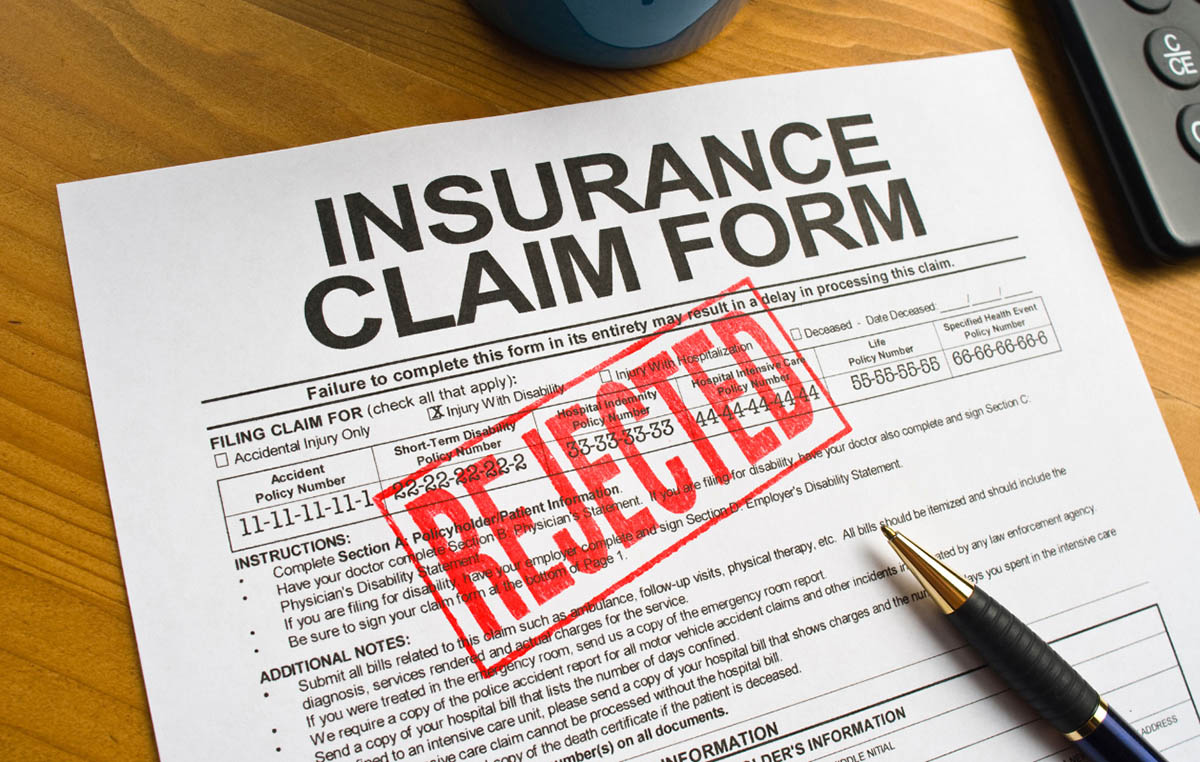Home>Finance>How To File A No-Fault Insurance Claim In New York


Finance
How To File A No-Fault Insurance Claim In New York
Published: November 10, 2023
Learn how to file a no-fault insurance claim in New York and get the financial reimbursement you deserve.
(Many of the links in this article redirect to a specific reviewed product. Your purchase of these products through affiliate links helps to generate commission for LiveWell, at no extra cost. Learn more)
Table of Contents
Introduction
When it comes to dealing with auto accidents and the resulting medical expenses, having a no-fault insurance policy can be a lifesaver. No-fault insurance, also known as personal injury protection (PIP), is a type of coverage that pays for your medical bills and certain other related expenses regardless of who is at fault for the accident. This means that you won’t have to go through the lengthy process of determining fault and pursuing a claim against the other party.
While no-fault insurance offers convenience and efficiency, it’s important to understand the process of filing a claim to ensure you receive the benefits you’re entitled to. In this article, we will guide you through the steps of filing a no-fault insurance claim in New York.
New York State is one of the few states in the U.S. that requires drivers to carry no-fault insurance coverage. The purpose of this requirement is to provide prompt and efficient payment of medical expenses and other necessary expenses resulting from an auto accident, regardless of who caused the accident. Understanding the process can help you navigate through the complexities of filing a claim and ensure that you receive the compensation you’re entitled to.
Whether you’re a New York resident or visiting the state and involved in an accident, it’s crucial to know how to file a no-fault insurance claim. By following the necessary steps and providing the required documentation, you can expedite the processing of your claim and receive the financial assistance you need during this challenging time.
Now that you understand the importance of no-fault insurance and the significance of filing a claim, let’s delve into the step-by-step process to ensure that you are familiar with every aspect of it.
Understanding No-Fault Insurance
No-fault insurance is a type of auto insurance coverage that is designed to provide quick and efficient compensation for medical expenses and other necessary expenses resulting from a car accident. In states where no-fault insurance is required, such as New York, it is mandatory for drivers to carry this coverage.
One of the key features of no-fault insurance is its focus on providing benefits regardless of who is at fault for the accident. This means that even if you are responsible for the accident, you can still receive compensation for your medical bills and related expenses.
Under a no-fault insurance policy, you are required to file a claim with your own insurance company to receive the benefits. This eliminates the need for lengthy investigations to determine fault, allowing you to receive assistance quickly. However, it’s important to note that no-fault insurance typically has a limit on the amount of coverage provided, so it’s crucial to understand the terms and limits of your policy.
In New York, the minimum coverage limits for no-fault insurance are $50,000 per person for medical expenses and $2,000 for loss of wages or earning capacity. This means that your insurance company will cover up to $50,000 in medical expenses for each person injured in the accident, regardless of fault.
It’s important to note that no-fault insurance only covers medical expenses and certain other expenses directly related to the accident. It does not cover property damage or damages related to pain and suffering. To seek compensation for these types of damages, you may need to pursue a separate claim against the at-fault driver.
Understanding the limitations and benefits of no-fault insurance can help you navigate the claims process more effectively. Additionally, it’s important to review the specific terms of your policy and consult with your insurance provider to ensure you are fully aware of your rights and coverage.
Now that you have a basic understanding of no-fault insurance, let’s move on to the step-by-step process of filing a no-fault insurance claim in New York.
Step 1: Notify Your Insurance Company
After being involved in a car accident in New York, the first and most important step in filing a no-fault insurance claim is to notify your insurance company. It is crucial to do this as soon as possible to ensure that you meet the required reporting deadlines and initiate the claims process.
When notifying your insurance company, provide them with all the necessary details of the accident, including the date, time, location, and a brief description of what happened. Be prepared to provide your policy information, including the policy number and any other relevant details.
New York law requires that you report the accident to your insurance company within 30 days. However, it is highly recommended to notify them as soon as possible after the accident. Failing to report the accident promptly may result in a denial or delay of your claim.
During the notification process, your insurance company may ask you various questions to gather more information about the accident and the damages incurred. Answer these questions truthfully and provide as much detail as possible to ensure an accurate assessment of your claim.
If you were injured in the accident, make sure to inform your insurance company about your injuries and any immediate medical treatment that you received. This will help them understand the extent of your injuries and ensure that necessary medical expenses are covered by the no-fault insurance policy.
Once you have notified your insurance company, they will guide you through the next steps of the claims process and provide you with the necessary forms and documentation requirements. Keep a record of all communications with your insurance company, including the names of the representatives you spoke to and the dates of the discussions.
By promptly notifying your insurance company, you lay the foundation for a smooth and efficient claims process. It’s important to remember that complying with the reporting requirements and providing accurate information are crucial for a successful no-fault insurance claim in New York.
In the next section, we will discuss the steps you need to take to gather the necessary documentation for your claim.
Step 2: Gather Documentation
Once you have notified your insurance company about the car accident and initiated the claims process, the next step is to gather all the necessary documentation to support your no-fault insurance claim in New York. The documentation you provide will serve as evidence of the accident and the resulting injuries and expenses, helping to validate your claim and ensure you receive the compensation you’re entitled to.
Here are some key documents you should gather:
- Police Report: If law enforcement responded to the accident, obtain a copy of the police report. This report contains important details about the accident, such as the date, time, location, and any citations issued.
- Medical Records: Collect all medical records related to your injuries, including emergency room visits, hospital stays, diagnostic tests, surgical procedures, and consultations with healthcare providers. These records should clearly document the extent of your injuries and the treatment you received.
- Proof of Expenses: Keep track of all medical bills, prescription receipts, and invoices from healthcare providers. This includes bills for hospital stays, ambulance services, rehabilitation sessions, and any other medical expenses incurred as a result of the accident.
- Proof of Lost Wages: If you missed work due to your injuries, obtain a letter from your employer confirming the dates you were unable to work and any income you lost as a result. This documentation will validate your claim for loss of wages.
- Photographs and Videos: If possible, take photographs or videos of the accident scene, the damages to your vehicle, and any visible injuries you sustained. These visual records can provide evidence of the severity of the accident and the impact it had on your physical well-being.
- Witness Statements: If there were witnesses to the accident, obtain their contact information and request written statements about what they saw. Witness statements can help corroborate your version of events and strengthen your claim.
It’s essential to gather these documents as soon as possible after the accident, while the details are fresh in your mind and the evidence is readily available. Keep all the documents in a safe and organized manner, making copies for both yourself and your insurance company. This will ensure that you have the necessary proof to support your no-fault insurance claim.
In the next section, we will discuss how to complete the no-fault application, another important step in the claims process.
Step 3: Complete the No-Fault Application
After gathering all the necessary documentation for your no-fault insurance claim in New York, the next step is to complete the no-fault application. This application is a formal request for benefits under your no-fault insurance policy and is a crucial part of the claims process.
The no-fault application, also known as the NF-2 form, is provided by your insurance company. It typically asks for detailed information about the accident, your injuries, and the medical treatment you have received. The application may also require you to provide information about your health insurance coverage, employment details, and any other relevant information concerning the accident.
When completing the no-fault application, take the time to gather all the necessary information and provide accurate and detailed responses. Be as thorough as possible, as incomplete or inconsistent information may cause delays or possible denial of your claim.
Here are some important points to remember when completing the no-fault application:
- Provide Accurate Details: Ensure that you accurately provide all the required information, including the date, time, and location of the accident, as well as a detailed description of how the accident occurred.
- Describe Your Injuries: Clearly describe the injuries you sustained as a result of the accident. Include details about the body parts affected, the severity of the injuries, and any other relevant information provided by your healthcare providers.
- Medical Treatment Information: Provide a detailed account of the medical treatment you have received and continue to receive for your injuries. Include information about the healthcare providers you have visited, the dates of the visits, and the type of treatment received.
- Employment and Income Details: If you have missed work due to your injuries, provide accurate information about your employment, including your job title, employer’s name, and the dates you were unable to work. Include details of any income you have lost as a result.
- Submit Supporting Documentation: Attach copies of the documentation you gathered in Step 2, such as medical records, bills, and any other relevant supporting documents.
Make sure to review the completed no-fault application thoroughly before submitting it to your insurance company. Double-check for accuracy and completeness to minimize the risk of any issues during the claims process.
Submitting the no-fault application is a critical step in moving your claim forward. Once your insurance company receives your completed application, they will begin processing your claim and evaluating your eligibility for the benefits provided by your no-fault insurance policy.
In the next section, we will discuss how to submit the claim to your insurance company.
Step 4: Submit the Claim
After completing the no-fault application, the next step in filing a no-fault insurance claim in New York is to submit the claim to your insurance company. This involves sending all the necessary documentation and forms to initiate the processing of your claim.
Here’s how to effectively submit your claim:
- Compile All Documents: Gather all the necessary documents, including the completed no-fault application (NF-2 form) and the supporting documentation such as medical records, bills, and other relevant paperwork.
- Make Copies: Make copies of all the documents for your own records. It’s essential to have a duplicate set in case anything gets lost or misplaced during the claims process.
- Organize the Package: Organize the documents in a clear and orderly manner. Use paperclips or folders to keep everything neatly organized and ensure that the insurance company can easily review the information.
- Submit the Claim: Send the entire claim package to your insurance company. Follow their preferred method of submission, whether it’s through regular mail, fax, or online portal. Make sure to retain proof of submission, such as tracking numbers or receipts.
When submitting the claim, it’s important to do so within the designated time frame specified by your insurance company. Failure to meet the deadlines may lead to delays or potential denial of your claim.
After submitting the claim, it’s advisable to follow up with your insurance company to confirm receipt of the documents and inquire about the next steps in the claims process. This will help ensure that your claim is being processed promptly and provide you with an opportunity to address any additional requirements or inquiries from the insurance company.
Remember to keep copies of all communication with your insurance company, including any correspondence or conversations related to your claim. This will serve as a record of your interactions and help you stay organized throughout the claims process.
In the next section, we will discuss the importance of following up with your insurance company after submitting the claim.
Step 5: Follow Up with Your Insurance Company
After submitting your no-fault insurance claim to your insurance company, it’s essential to follow up with them to ensure that your claim is being processed effectively and efficiently. Regular communication and follow-up can help address any issues or discrepancies that may arise during the claims process and ensure that you receive the compensation you deserve.
Here are some key points to consider when following up with your insurance company:
- Contact the Claims Department: Reach out to the claims department of your insurance company to inquire about the status of your claim. Keep a record of the date and time of your conversation and the name of the representative you spoke with.
- Provide Additional Information: If your insurance company requests any additional information or documentation to support your claim, promptly provide them with the requested materials. This will help avoid delays in the claims process.
- Clarify Inquiries: If your insurance company has any questions or concerns about your claim, be responsive and provide clear and concise explanations. Address any issues promptly and provide any necessary evidence or documentation to support your case.
- Document All Communication: Keep detailed records of all communication with your insurance company, including emails, letters, and phone conversations. This will help you keep track of any updates or changes regarding your claim.
- Be Persistent: If you are experiencing delays or facing unresponsive customer service, don’t hesitate to escalate your concerns to a supervisor or a higher authority within the insurance company. Persistence can often help expedite the processing of your claim.
- Seek Legal Assistance if Necessary: If you encounter challenges or roadblocks during the claims process, it may be wise to consult with an attorney who specializes in personal injury or insurance claims. They can provide you with expert guidance and advocate on your behalf, helping you navigate the complexities of the claims process.
By actively following up with your insurance company, you can stay informed about the progress of your claim and ensure that any issues are addressed promptly. Effective communication and documentation are vital in achieving a successful outcome for your no-fault insurance claim.
In the final section, we will discuss the importance of seeking legal assistance if needed to protect your rights and maximize your claim.
Step 6: Seek Legal Assistance if Necessary
While filing a no-fault insurance claim in New York is designed to be a straightforward process, there are situations where seeking legal assistance can be beneficial. If you encounter challenges, disputes, or concerns during the claims process, consulting with an attorney who specializes in personal injury or insurance claims can help protect your rights and maximize your claim.
Here are some instances where seeking legal assistance may be necessary:
- Claim Denial: If your insurance company denies your no-fault insurance claim, it is crucial to seek legal advice. An attorney can review the denial and help determine if you have grounds for an appeal or if further action, such as filing a lawsuit, is necessary.
- Disputed Liability: If there is a dispute regarding liability for the accident, an attorney can help gather evidence and present a strong case to protect your rights and ensure that you receive the compensation you deserve.
- Complex Injuries: If you sustained severe injuries that require extensive medical treatment, long-term care, or have resulted in permanent disability, an attorney can help ensure that you receive adequate compensation for your current and future medical expenses, lost wages, and pain and suffering.
- Unfair Settlement Offers: If the insurance company offers a settlement that is significantly lower than you believe you are entitled to, an attorney can negotiate on your behalf and advocate for a fair and just settlement.
- Overall Guidance and Support: Even if your claim seems straightforward, having legal representation can provide valuable guidance and support throughout the claims process. An attorney can help you navigate any legal complexities, answer your questions, and ensure that your rights are protected every step of the way.
When seeking legal assistance, it’s important to choose an attorney with expertise in personal injury law and experience with no-fault insurance claims in New York. They will have a deep understanding of the local laws, regulations, and processes, increasing the likelihood of a successful outcome for your claim.
Remember, consulting an attorney should be done as soon as possible, especially if you anticipate significant challenges or disputes in your claim. They can provide you with personalized advice based on the specifics of your situation, ensuring that your rights are protected and that you receive fair compensation for your injuries and damages.
As a final note, let’s recap the steps we’ve covered to file a no-fault insurance claim in New York.
Conclusion
Filing a no-fault insurance claim in New York can be a straightforward process if you understand the necessary steps and requirements. By following the steps outlined in this guide, you can navigate the claims process with confidence and increase your chances of a successful outcome.
Remember to promptly notify your insurance company of the accident and gather all the necessary documentation to support your claim. Completing the no-fault application accurately and thoroughly is crucial, as it serves as a formal request for benefits under your policy.
Submitting your claim package to your insurance company and following up with them regularly will help ensure that your claim is processed efficiently. In some cases, seeking legal assistance may be necessary, especially if your claim is denied, liability is disputed, or your injuries are severe.
Understanding your rights and responsibilities under no-fault insurance is essential. While no-fault coverage provides benefits for medical expenses and certain expenses resulting from an accident, it does not cover property damage or damages related to pain and suffering.
By staying organized, documenting communication, and advocating for your rights, you can increase your chances of receiving the compensation you are entitled to under your no-fault insurance policy.
If you have any questions or concerns during the claims process, don’t hesitate to consult with an attorney who specializes in personal injury or insurance claims. They can provide you with expert guidance and support to navigate any legal complexities.
Remember, the most important thing is to prioritize your health and well-being after an accident. Focus on healing and recovery while taking the necessary steps to file your no-fault insurance claim.
We hope this guide has provided you with valuable insights and guidance on filing a no-fault insurance claim in New York. By following the steps outlined here, you can navigate the process with confidence and secure the financial assistance you need during this challenging time.














